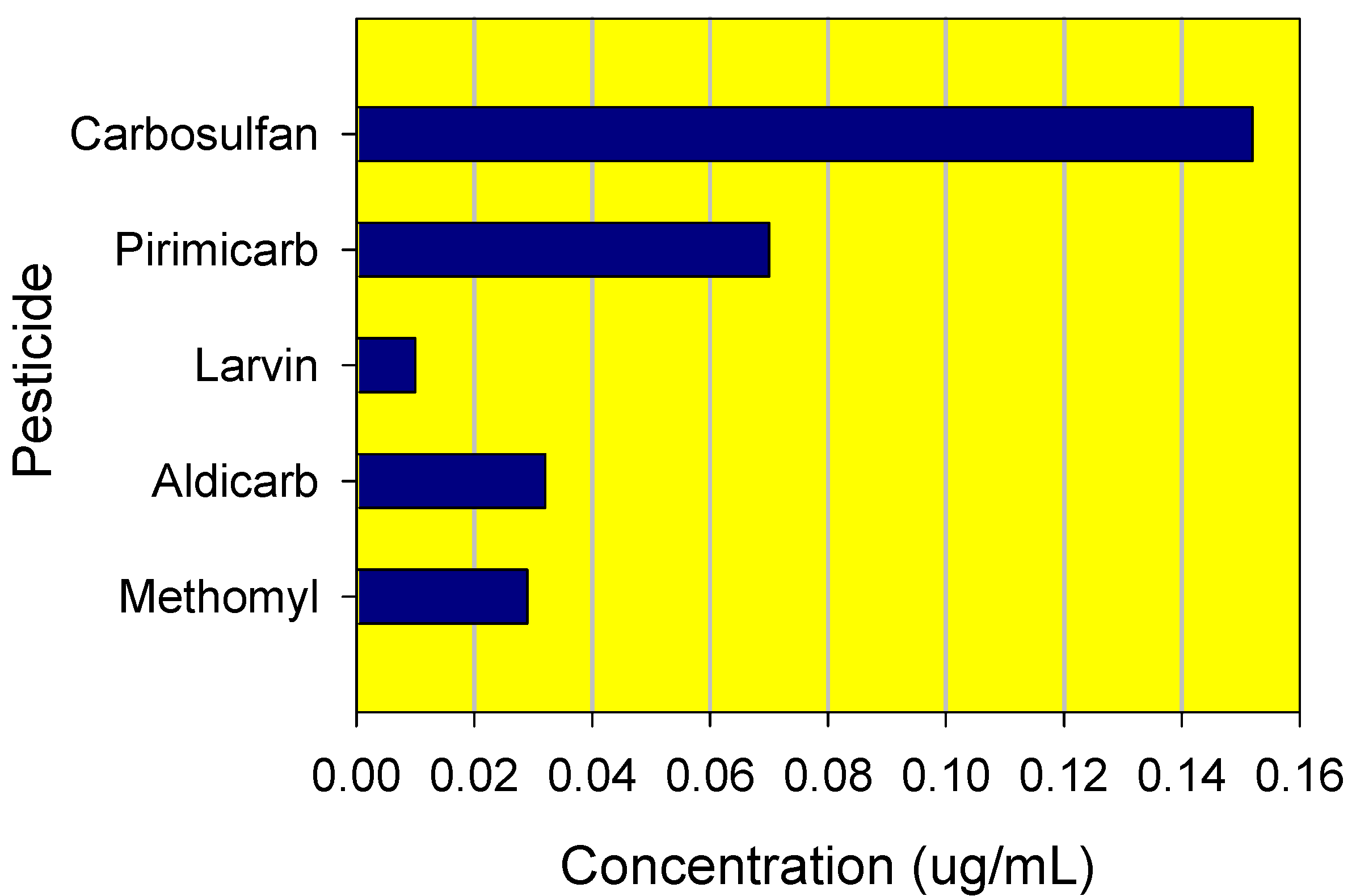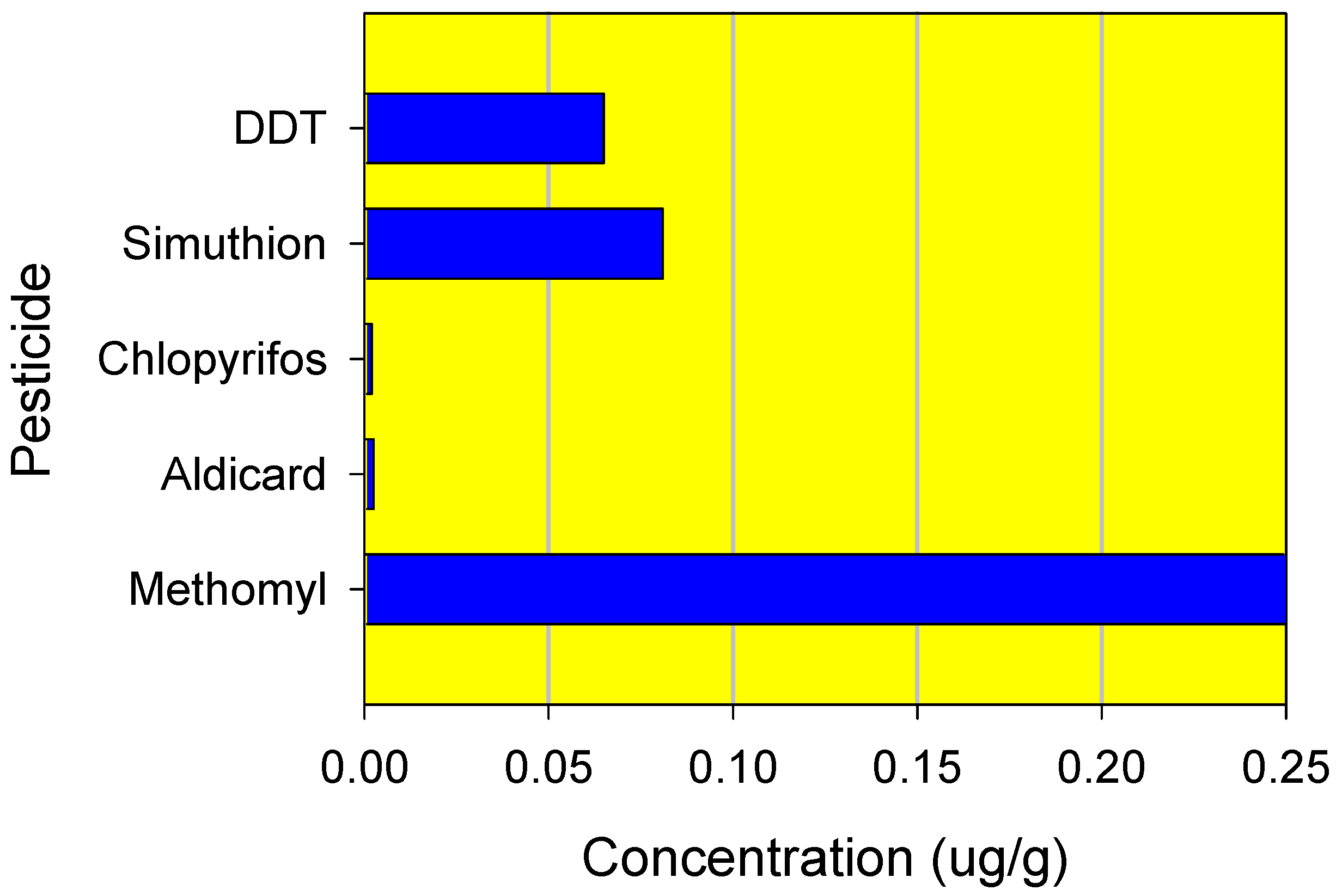Health Risk Assessment of Pesticide Usage in Menia El-Kamh Province of Sharkia Governorate in Egypt
Abstract
:Introduction
Materials and Methods
Field Investigations
Sample Extraction
Sample Analysis
Health Risks Estimation
Results
Field Survey
Pesticide Analysis





Health Risk Estimates
| Pesticide | Reference dose (mg/kg/day) | Estimated dose (mg/kg/day) | Hazard index | Health risk |
|---|---|---|---|---|
| Aldicarb | 0.0013 | 0.0014 – Adults | 1.08 | Yes |
| 0.0094 – Children | 7.23 | Yes | ||
| Carbofulfan | 0.0100 | 0.0065 – Adults | 0.65 | No |
| 0.0450 – Children | 4.50 | Yes | ||
| Chlorpyrifos | 0.0030 | 5×10-7 – Adults | 2×10-4 | No |
| 4×10-6 – Children | 1×10-3 | No | ||
| DDT | 0.0005 | 2×10-5 – Adults | 4×10-2 | No |
| 2×10-4 – Children | 4×10-1 | No | ||
| Dimethoate | 0.0002 | 6×10-5 – Adults | 0.30 | No |
| 4×10-4 – Children | 2.00 | Yes | ||
| Methomyl | 0.0300 | 0.0015 – Adults | 0.05 | No |
| 0.0102 – Children | 0.34 | No |
| Pesticide | Lifetime health advisory (A-µg/L) | Ground water concentration (B-µg/L) | Margin of exposure (C = B/A) | Health risk |
|---|---|---|---|---|
| Aldicarb | 10 | 32 | 3.20 | Yes |
| Carbofulfan | 40 | 152 | 3.80 | Yes |
| Larvin | — | 10 | — | — |
| Methomyl | 200 | 29 | 0.15 | No |
| Pirimicarb | — | 72 | — | — |
Discussion
Field Survey
Pesticide Analysis
Health Risk Assessment
Conclusions
Acknowledgments
References
- Nassar, S. The strategy of agricultural development in Egypt in the 1990s. In Crop Health Conference: Future of Integrated Pest Management in Crop Health and Sustainable Agriculture, Fayoum, Egypt; 1994. [Google Scholar]
- Zalom, F. G. Pesticide use practices in integrated pest management. In Handbook of Pesticide ToxicologyKrieger, R., Doull, J., Ecobichon, D., Gammon, D., Hodgson, E., Reiter, L., Ross, J., Eds.; Academic Press: New York, NY, 2nd Ed.; 2001; pp. 275–283. [Google Scholar]
- Calvert, G. M.; Sanderson, W. T.; Barnett, M.; Blondell, J. M.; Melher, L. N. Surveillance of pesticide-related illness and injury in humans. In Handbook of Pesticide ToxicologyKrieger, R., Doull, J., Ecobichon, D., Gammon, D., Hodgson, E., Reiter, L., Ross, J., Eds.; Academic Press: New York, NY, 2nd Ed.; 2001; pp. 603–641. [Google Scholar]
- Snodgrass, W. R. Diagnosis and treatment of poisoning due to pesticides. In Handbook of Pesticide ToxicologyKrieger, R., Doull, J., Ecobichon, D., Gammon, D., Hodgson, E., Reiter, L., Ross, J., Eds.; Academic Press: New York, NY, 2nd Ed.; 2001; pp. 589–602. [Google Scholar]
- Ashour, M. B-A. Residual Effects of Certain Soil Pesticides. M. Sc. Thesis, Zagaziz University, Egypt, 1976. [Google Scholar]
- Ashour, M. B-A. Side Effects of Organophosphorus Insecticides on Plants. Ph. D. Thesis, Zagaziz University, Egypt, 1979. [Google Scholar]
- Ashour, M. B-A.; Ramadan, R. A.; Ragheb, D. A.; Gomaa, A. A.; Monrad, S. J. Thiodicarb and aldicarb residues in potatoes. In Proc. 2nd National Conference on Pest Diseases of Vegetables and Fruits, Ismailia, Egypt; 1987; pp. 501–513. [Google Scholar]
- Dogheim, S. M.; Nasr, E. N.; Almaz, M. M.; El-Tohamy, M. M. Pesticide residues in milk and fish collected from two Egyptian Governorates. J. Official Anal. Chem. 1990, 73, 19–21. [Google Scholar]
- Amer, M. M. Pesticide intoxication in Egypt. In Crop Health Conference: Future of Integrated Pest Management in Crop Health and Sustainable Agriculture, Fayoum, Egypt; 1994. [Google Scholar]
- Horrigan, L.; Lawrence, R. S.; Walker, P. How sustainable agriculture can address the environmental and human health harms of industrial agriculture. Environ. Health Perspect. 2002, 110, 445–456. [Google Scholar] [CrossRef] [PubMed]
- Raschke, A. M.; Burger, A. E. C. Risk assessment as a management tool used to assess the effects of pesticide use in an irrigation system situated in a semi-desert region. Arch. Environ. Contam. Toxicol. 1997, 32, 42–49. [Google Scholar] [CrossRef] [PubMed]
- FAO/WHO. Report of the Thirty-Fourth Session of the Codex Committee on Pesticide Residues. Food and Agriculture Organization of the United Nations / World Health Organization: The Hague, Netherlands, May 2002. [Google Scholar]
- U.S. EPA. Test Methods for Evaluating Solid Wastes SW-846. Volume IA-Laboratory Manual: Physical and Chemical Methods. United States Environmental Protection Agency. Office of Solid Waste and Emergency Response: Washington, D.C., 1994. [Google Scholar]
- Youssef, S. H.; Samaan, M. A.; El-Shemy, M. K. H. Monitoring pesticide residues in canals, boreholds and tapwater during chemical control of cotton pest in Egypt. Egypt. J. Appl. Sci. 1992, 7(7), 171–180. [Google Scholar]
- Ramadan, R. A.; Saleh, M. A.; El-Shemy, M. K. Residues of some pesticides on and in cucumber, green pepper, and eggplant fruits under plastic green house conditions. Egypt. J. Appl. Sci. 1992, 7(8), 861–870. [Google Scholar]
- U.S. EPA. Exposure Assessment Handbook. United States Environmental Protection Agency. Office of Health and Environmental assessment: Washington, D.C., 1989. [Google Scholar]
- U.S. EPA. Integrated Risk Information System. United States Environmental Protection Agency. Office of Health and Environmental assessment: Washington, D.C., 1996. [Google Scholar]
- Tchounwou, P. B.; Abdelghani, A. A.; Pramar, Y. V.; Heyer, L. R.; Steward, C. M. Assessment of potential health risks associated with ingesting heavy metals in fsh collected from a hazardous waste contaminated wetland in Louisiana. Rev. Environ. Health 1996, 11(4), 1–13. [Google Scholar] [CrossRef] [PubMed]
- Tchounwou, P. B.; Abdelghani, A. A.; Pramar, Y. V.; Heyer, L. R. Health risk assessment of hexachlorobenzene and hexachlorobutadiene residues in fish collected from a hazardous waste contaminated wetland in Louisiana. Environ. Toxicol. Risk Assess. 1996, 1333, 368–382. [Google Scholar]
- Turusov, V.; Rakitsky, V.; Tomatis, L. Dichlorodiphenyltrichloroethane (DDT): ubiquity, persistence and risks. Environ. Health Perspect. 2002, 110(2), 125–128. [Google Scholar] [CrossRef] [PubMed]
- Wesseling, C.; Van Wendel de, Joode B.; Ruepert, C.; Leon, C.; Monge, P.; Hermosillo, H.; Partanen, T. J. Paraquat in developing countries. Int. J. Occup. Environ. Health 2001, 7(4), 275–286. [Google Scholar] [CrossRef] [PubMed]
- Raminez, V.; Cuenca, P. Micronuclei frequency in lymphocytes of individuals occupationally exposed to pesticides. Rev. Biol. Trop. 2001, 49(1), 1–8. [Google Scholar] [PubMed]
- Arbuckle, T. E.; Lin, Z.; Mery, L. S. An exploratory analysis of the effect of pesticide exposure on the risk of spontaneous abortion in an Ontario farm population. Environ. Health Perspect. 2001, 109(8), 851–857. [Google Scholar] [CrossRef] [PubMed]
- Rojas, A.; Ojeda, M. A.; Barraza, X. Congenital malformations and pesticide exposure. Rev. Med. Chil. 2000, 128(4), 399–404. [Google Scholar] [CrossRef] [PubMed]
- McDuffite, A. H.; Pahwa, P.; McLaughlin, J. R.; Spinelli, J. J.; Fincham, S.; Dosman, J. A.; Robson, D.; Skinnider, L.F.; Choi, N. W. Non-Hodgskin’s lymphoma and specific pesticides exposure in men: Cross Canada study of pesticides and health. Cancer Epidemiol. Biomarkers Prev. 2001, 10(11), 1155–1163. [Google Scholar] [PubMed]
- Payne, J.; Scholze, M.; Koetenkamp, A. Mixtures of organochlorides enhance huamn breast cancer cell proliferation. Environ. Health Perspect. 2001, 109(4), 391–397. [Google Scholar] [CrossRef] [PubMed]
- Badawi, A. F.; Michael, M. S. Risk factors of hepatocellualr carcinoma in Egypt: The role of hepatitis-B viral infection and schistosomiasis. Anticancer Res. 1999, 109(5), 4565–4569. [Google Scholar] [PubMed]
- Shalaby, A. A. Residues of some of some insecticides on and in broad bean plants. Egypt. J. Appl. Sci. 1992, 7(11), 531–539. [Google Scholar]
- Doghein, S. M.; Gadd Alla, S. A.; El-Marsafy, A. M.; Fahmy, S. M. Monitoring pesticide residues in Egyptian fruits and vegetables in 1995. J. Assoc. Official Analyt. Chemists Intl. 1999, 82(4), 948–955. [Google Scholar]
- Goldman, L. R.; Koduru, S. Chemicals in the environment and developmental toxicity to children: a public health and policy perspective. Environ. Health Perspect. 2001, 109(9), 412–413. [Google Scholar] [CrossRef]
- Bruckner, J. V. Differences in sensitivity of children and aduls to chemical toxicity: The NAS panel report. Regul. Toxcicol. Pharmacol. 2000, 31(3), 280–285. [Google Scholar] [CrossRef]
© 2002 by MDPI (http://www.mdpi.org).
Share and Cite
Tchounwou, P.B.; Ashour, B.A.; Moreland-Young, C.; Ragheb, D.A.; Romeh, A.A.; Goma, E.-A.; El-Sheikh, S.; Lidell, F.P.; Ibitayo, O.; Assad, J.-C. Health Risk Assessment of Pesticide Usage in Menia El-Kamh Province of Sharkia Governorate in Egypt. Int. J. Mol. Sci. 2002, 3, 1082-1094. https://0-doi-org.brum.beds.ac.uk/10.3390/i3101082
Tchounwou PB, Ashour BA, Moreland-Young C, Ragheb DA, Romeh AA, Goma E-A, El-Sheikh S, Lidell FP, Ibitayo O, Assad J-C. Health Risk Assessment of Pesticide Usage in Menia El-Kamh Province of Sharkia Governorate in Egypt. International Journal of Molecular Sciences. 2002; 3(10):1082-1094. https://0-doi-org.brum.beds.ac.uk/10.3390/i3101082
Chicago/Turabian StyleTchounwou, Paul B., Bassem A. Ashour, Curtina Moreland-Young, Didair A. Ragheb, Ahmed A. Romeh, El-Adarosy Goma, Sayed El-Sheikh, Frances P. Lidell, Olurominiyi Ibitayo, and Jean-Claude Assad. 2002. "Health Risk Assessment of Pesticide Usage in Menia El-Kamh Province of Sharkia Governorate in Egypt" International Journal of Molecular Sciences 3, no. 10: 1082-1094. https://0-doi-org.brum.beds.ac.uk/10.3390/i3101082





